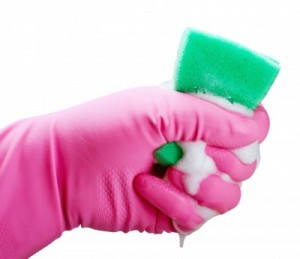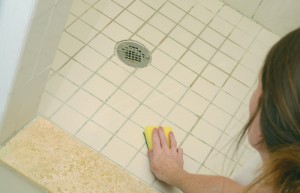Monthly Archives: August 2013
Unless you’re redecorating your Cranston or Woonsocket bathroom with a “science project” theme, mold growing on your ceiling is probably not the look you were hoping for.
project” theme, mold growing on your ceiling is probably not the look you were hoping for.
Mold can also cause serious structural damage to your home if left unattended along with respiratory problems, including severe allergies and asthma. So if you see it – mold, that is – attack it, because it’s only going to get worse.
Step 1: Treat the mold with bleach-diluted with water and a gentle detergent.
Put the solution in a spray bottle or use a sponge to lightly dab it onto the moldy spots. Either way, wear gloves and a mask to protect yourself from the noxious vapors. Also, don’t apply too much of the mixture to the ceiling; over-applying can saturate the ceiling and make it difficult to dry.
Step 2: Look for the source of the mold.
Mold grows from excessive moisture and warmth, so you’ll need to investigate to determine the source of the problem. Is the mold localized above the shower only? It could be that your ventilation fan in the bathroom is incorrectly connected and is not properly venting the excess steam from the shower. If there is no ventilation fan installed, then you’ll need to install one, but that won’t get rid of the mold you already have.
The problem could also have started above the ceiling in your attic or perhaps another bathroom directly overhead. Another bathroom could have leaking pipes in the floor, or perhaps the tub needs to be re-caulked.
If you have a leak in your attic, over time mold will begin to grow, especially in the summer when most attics are too hot for comfort.
Step 3: Prime the ceiling before painting.
Use an anti-microbial primer before repainting the ceiling. Otherwise, the mold stains can seep through your fresh paint.
Step 4: Repaint using specially-formulated bathroom paint.
Use a paint that is specifically designed for high moisture areas like your bathroom. It will help to keep mold from returning.
With our often hot and sticky summers here in Rhode Island, thousands of home owners experience mold-related problems. We know, because we get tons of calls for assistance. Today, like always, we’re ready to assist you in helping to make mold a thing of the past in your home and to help correct any problems it might already have caused. So contact Almeida Plumbing, Heating & Air today for fast and decisive action.
401-273-0040
Click here to request a quote or schedule service now
If you’ve never experienced mold growth in your bathroom, consider yourself quite lucky. Truth is, bathroom mold is a very common occurrence and can be more than just unsightly if left untreated. Mold can exasperate allergy and asthma symptoms, and increase the severity of other respiratory conditions.
So what can you do to prevent mold growth? Well, since mold thrives in dark, damp, and warm environments, keeping your bathroom well ventilated is the first defense. Be sure to run your ventilation fan any time you take a bath or shower, and keep it running for at least 10 minutes after you’re done. Longer is better. Also, routinely remove dust and debris from you fan for smoother operation and cleaner air.
Unfortunately, however, mold can still creep into your bath and shower area no matter how hard you try to ward it off. In this case, it’s best to remove it immediately. While bleach is often touted as the “go-to” solution, it doesn’t work on porous surfaces. Plus it’s highly toxic and releases dangerous fumes into the air. The following three alternatives are not only safer for your family and the environment, they are some of the most effective ways to kill and remove mold.
- Borax – mix 1 cup of Borax to 1 gallon of water and scrub the mold off the surface with a scrub brush. Wipe up any excess moisture, dust, or mold particles and allow the surface to dry completely. No need to rinse as the Borax will prevent new mold growth.
- Vinegar – Pour distilled white vinegar into a spray bottle. Spray it directly on the moldy surface and allow it to sit for an hour. Wipe the area clean and allow it to dry completely.
- Baking Soda – Add ¼ teaspoon of baking soda to a spray bottle of water and shake to dissolve. Spray the area with the solution, then scrub with a brush to loosen and remove the mold. Rinse the area with water, and spray with the baking soda solution once again, and leave to dry.
If, despite your best efforts, you still have a mold problem on your hands, contact Almeida Plumbing, Heating & Air today for professional help in making your home mold free.
401-273-0040
Click here to request a quote or schedule service now




